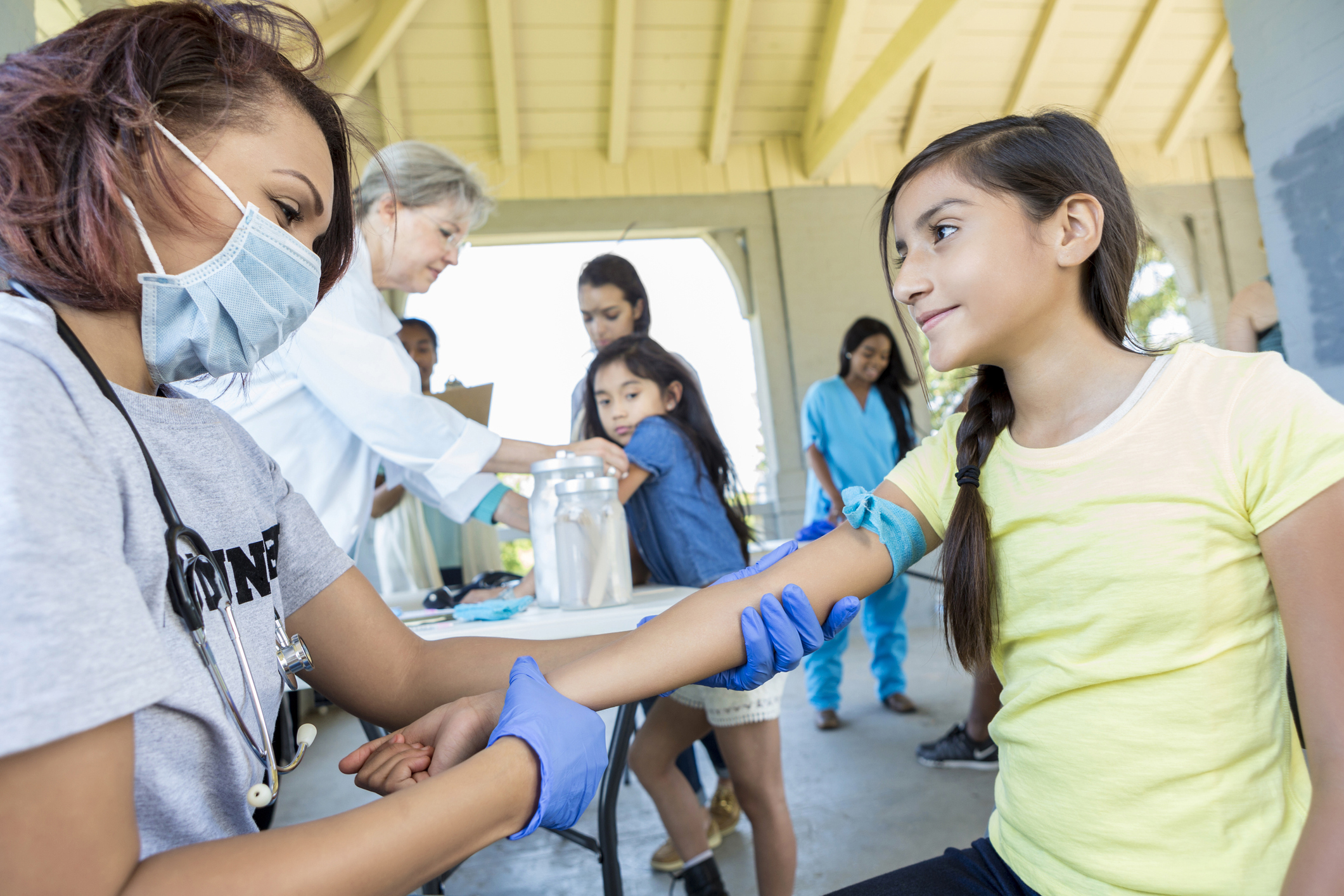Social Determinants of Health
For many patients, zip code is a better predictor of their health than genetic code.
The clinician’s core role is to provide health care to individual patients. Nonetheless, recognizing the underlying social, economic, and political factors that shape population health, including firearm injury risk, can help clinicians make informed recommendations, address the root causes of the problem, and prevent future firearm injury among their patients.
What are the Social Determinants of Health?
According to the social ecological model—a popular public health framework—people are situated within multiple, intersecting spheres of influence, ranging from the micro-level (individual) to the meso-level (relationships and community) to the macro-level (societal), which influence their health and development.1 While the medical profession typically operates on the individual level, an approach incorporating the social determinants of health directs attention to the outer spheres of influence. Identifying upstream factors can enable clinicians to understand and address the underlying conditions (or root causes) that contributed to their patients’ health problems in the first place and tailor their therapeutic interventions to the individual’s situation.
The World Health Organization defines the social determinants of health as “the conditions in which people are born, grow, work, live, and age, and the wider set of forces and systems shaping the conditions of daily life.”2 These forces and systems include political institutions, economic systems, social policies, and cultural values, which control the distribution of money, power, and access to resources in society. Put another way, social determinants of health are the non-medical factors that influence health outcomes, some of which include:
- educational opportunity
- income
- housing stability
- work conditions
- physical environment
- discrimination
- social support and inclusion
- access to health care
Research estimates that roughly 60% of premature deaths in the US are attributable to social, environmental, and behavioral factors outside of clinical care.3 A smaller proportion are due to genetic predispositions (30%) and shortfalls in the availability and quality of medical care (10%). Many of the conditions driving the need for medical treatment are preventable, and addressing these conditions is essential to promoting health and preventing injury and disease.
Recognizing the social determinants of health can enhance clinicians’ understanding of who’s at risk of firearm injury and how to prevent it.
Structural Inequities & Firearm Violence
The social determinants of health play a fundamental role in shaping health inequities—the unjust and avoidable differences in health status between different groups.4 Some people face more obstacles than others in accessing the resources and opportunities needed to experience their full potential for health, safety, and wellbeing. These marginalized and excluded groups include people of color, people living in poverty, religious minorities, sexual and gender minorities, people with physical or mental disabilities, and women.
 Firearm injury and death are no exception. Firearm violence and suicide disproportionately impact socially and economically disadvantaged groups, and growing evidence suggests that firearm violence is both a cause and a consequence of inequality.5-12 Decreased economic prospects, substandard education systems, and housing instability contribute to a lack of community safety and social cohesion, which increases the risk of violence perpetration and victimization. Conversely, firearm violence diminishes the stock of physical, human, and social capital and affects economic activity, safety conditions, and the capacity of local governments, causing further inequality. Without systemic changes that address these broader societal factors, the cycle of inequality and firearm violence continues.
Firearm injury and death are no exception. Firearm violence and suicide disproportionately impact socially and economically disadvantaged groups, and growing evidence suggests that firearm violence is both a cause and a consequence of inequality.5-12 Decreased economic prospects, substandard education systems, and housing instability contribute to a lack of community safety and social cohesion, which increases the risk of violence perpetration and victimization. Conversely, firearm violence diminishes the stock of physical, human, and social capital and affects economic activity, safety conditions, and the capacity of local governments, causing further inequality. Without systemic changes that address these broader societal factors, the cycle of inequality and firearm violence continues.
Many of the policies and practices that contribute to the unequal distribution of firearm violence are rooted in structural racism, a form of inequity. Structural racism refers to all of the ways that societies foster racial discrimination through interconnected systems such as housing, education, employment, health care, and criminal justice.13 These systems reinforce discriminatory beliefs, values, and the distribution of resources. Though they might not explicitly mention race, policies such as restrictive zoning laws, mandatory minimum sentencing, and the criminalization of mental illness and substance use often reflect racist intent or have racist consequences, or both. These, in turn, fuel firearm violence and other adverse health outcomes among communities of color.
Click below for some examples:
Addressing the Social Determinants of Health
Clinicians can make an impact beyond individual patient care by advocating for changes in policies and practices related to social determinants of health.
Patients’ health outcomes, including firearm injury, are not simply the product of individual choices and behaviors. They are shaped by larger, societal forces that expand or constrain opportunities for achieving optimal health, safety, and wellbeing. Taking a broader view of patients’ health that considers their social context (including the supports and barriers in their environment) can help clinicians identify the root causes of health problems and make relevant and meaningful recommendations informed by the patient’s life circumstances. Clinicians can use online resources, such as the Area Deprivation Index Map (which shows neighborhoods’ level of disadvantage based on address), to better understand the conditions in the places where their patients live. Practicing cultural humility during patient encounters can increase clinicians’ awareness of the cultural, social, and structural factors that shape their patients’ experiences and opportunities.

Clinicians can also consider the non-medical resources that can be mobilized to assist patients. They can use screening tools, for example this Health Leads Screening Tool, to identify patients’ unmet social needs. Programs that integrate culturally-affirming social services with medical care, often using specialized case managers or community health workers, may improve patient outcomes by connecting patients with local resources, including food and housing assistance, legal services, mental health services, transportation, child care, and job training. Hospital-based violence intervention programs, which utilize violence intervention specialists, are an example of such programs that are specifically designed to disrupt the cycle of violence by treating violently injured patients’ complex social service needs and reducing their risk of violent reinjury.
Physicians can use their platform as respected authority figures in public discourse to voice the needs of their patients and to advocate for policy and practice change that targets structural inequities. They can collaborate with other sectors (e.g., lawyers, urban planners, community-based organizations) and community members to facilitate local changes. These efforts can promote more equitable health care systems and improve the conditions of daily life that place some communities at higher risk for firearm violence.
Dr. Nicole Kravitz-Wirtz and Dr. Shani Buggs from the UC Davis Violence Prevention Research Program contributed to this content.
Page last updated April 2021.
For more information, see these peer-reviewed articles.
Maani, N. & Galea, S. (2020). The role of physicians in addressing social determinants of health. JAMA.
Armstead, T. L., Wilkins, N., & Nation, M. (2019). Structural and social determinants of inequities in violence risk: A review of indicators. Journal of Community Psychology.
Jacoby, S. F., Dong, B., Beard, J. H., et al. (2018). The enduring impact of historical and structural racism on urban violence in Philadelphia. Social Science & Medicine.
Rowhani-Rahbar, A., Quistberg, D. A., Morgan, E. R., et al. (2019). Income inequality and firearm homicide in the US: a county-level cohort study. Injury Prevention.
Allchin, A., Chaplin, V., & Horwitz, J. (2018). Limiting access to lethal means: Applying the social ecological model for firearm suicide prevention. Injury Prevention.
Additional Resources on Social Determinants of Health
What is Health Equity? And What Difference Does a Definition Make?
This report is designed to increase consensus around the meaning of health equity and other key terms that often arise in discussions of health equity.
Prevent Firearm Suicide: Tools from EFSGV
EFSGV provides educational materials, initiatives, research, and resources for societal, community, relationship, and individual-level interventions for suicide prevention.
Unnatural Causes: Is Inequality Making Us Sick?
A seven-part documentary series and resources exploring racial and socioeconomic inequities in health.
What Can the Health Care Sector Do to Advance Health Equity?
This report discusses current health care sector initiatives to advance health equity and recommendations for action.
County Health Rankings & Roadmaps
Data, evidence, guidance, and examples to build awareness of the multiple factors that influence health and support community leaders working to improve health and increase health equity.
External ResourceMapping Life Expectancy
A series of maps that display life expectancy values in nearby neighborhoods to illustrate the connection between neighborhood conditions and health and start a conversation about the social determinants of health.